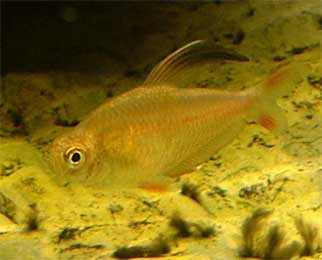Tetra - Rosy
Rosey Tetra Scientific Name: Hyphessobrycon bentosi rosaceus
Fri, 11th April, 2025 - 11:04 pm GMT
Sponsor Ads:

Alternative Name
Rosey Tetra Scientific Name: Hyphessobrycon bentosi rosaceusBasic Info
By maturity, Rosy Tetras can grow to one and a half inches (four centimeters) in length. Just as their name suggests, these fish are a rose color. Some are a bit darker, with hints of purple, while some are lighter in color, nearly peach in shade.
Health
Rosy Tetras are usually kept at temperatures between 75 and 82 degrees Fahrenheit (24 and 28 degrees Celsius). The pH value should remain between 6.0 and 7.5. Hiding places should be allowed, particularly at the sides of the enclosure to leave the center open for swimming. Rosy Tetras can be kept with other fish as long as the other fish will not eat or harass them. They usually do well when kept in small groups of their own species. Many people maintain their Rosy Tetras on flake or freeze-dried foods. Breeding Usually, male Rosy Tetras can be identified by their coloration, which is brighter than that of females, and their long dorsal and tail fins. Healthy Rosy Tetras usually breed readily when sexes are combined in fairly soft water. The breeding enclosure should include some finely leaved plants that the Tetras can lay their eggs in, and which the fry can hide in once they hatch. Hatching usually occurs within 24 hours, and the fry are fed on crushed flake food.Habitat
Fresh water fishBehavior
A beautiful, active little fish, the Rosy Tetra can make a cheerful addition for many aquariums. When kept in groups, these Tetras can be particularly interesting. The Rosy Tetra usually shows schooling behavior when kept with other members of its species. It is peaceful and usually does well in community tanks. However, if you are keeping your Rosy Tetra in a community environment, you should be sure that it is not bullied by other fish.Origin
South AmericaHistory
Rosy Tetras originate in South America, where they are normally found in the Rio Guapore region of Paraguay. They are also noted in the Amazon River basin, including Suriname and Guyana.Common Foods
N/ASponsor Ads:
Gratitude is merely the secret hope of further favors. --Anonymous
Tetra - Rosy
Coded by: BGID® | ALL RIGHTS RESERVED Copyright © 2000-2025
Disclaimer | Privacy | Report Errors / Contact | Credits








 Preparing For China. China is growing their military. China Military Technology - can it keep up with the US?
Preparing For China. China is growing their military. China Military Technology - can it keep up with the US?  versus
versus 

 versus
versus 
 This Thread is about the North Korean Military itself - the kind of army, navy, and air force they have.
This Thread is about the North Korean Military itself - the kind of army, navy, and air force they have. 
 versus
versus 
 versus
versus  versus
versus